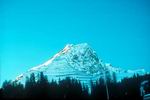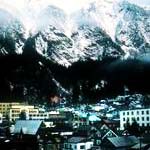| The snow sits charmingly
on the chalet roofs and the streets. No cars are permitted. Skiers can
slide right to their hotel doors, and guests are conveyed to their abode
by horse-drawn sleighs.
In contrast to Zermatt, modern towns in mountain settings can be insensitive
to environmental factors. Tall buildings can create their own negative
microclimates. They can block solar access and shadow streets and parks,
making them cold and uninviting. At Snowmass, Colo., the main shopping
mall rises three stories high along the south side of a central plaza.
Shops with entrances in the shade are not as prosperous as those with
entrances in the sun.
Modern cities in the cold country have a problem from the phenomenon
known as "aerodynamic shade," created when tall buildings
alter wind patterns, sheltering lower roofs from prevailing winds. Unanticipated
snow loads can build up on the lower, shadowed structures. Until building
codes deal with this special problem, the only solution is to design
all buildings for higher snow loads.
Avalanches are a hazard not adequately considered by cities in North
America. The typical avalanche slope is a barren, north-facing slope
with an angle of 30 to 40 degrees, although avalanches have occurred
on hills with all exposures and with slopes from 10 to 60 degrees. Steeper
slopes seldom avalanche because the snow slips off before dangerous
depths accumulate (Figure 15).
Juneau, Alaska's capital, faces the most severe avalanche danger of
any sizable city in the U.S. Major avalanches have swept the west-facing
Behrends Chute on Mt. Juneau six times in the past century.
Before 1946, there was only one building in the slide path; today there
are 30 houses, a 500-boat marina, part of a high school, and a motel
(Figure 16).
In 1972, the Borough of Juneau made an extensive study to define the
potential avalanche hazard. One expert predicted that a Juneau house
under the Behrends Chute has a 96 percent probability of being hit by
an avalanche if it stands for 40 years. The study suggested such precautions
as monitoring snowfall, developing warning and evacuation systems, controlling
the removal of vegetation and reforesting certain areas. The most practical
solution is to construct snow support structures high up on Mt. Juneau
and on the other high hills above the city. So far, little has been
done, and the people of Juneau seem nonchalant about the danger.
The majority of people in Juneau, together with many others who live
on avalanche prone sites, appear to feel that the danger is overstated.
This is a curious attitude in a nation that has building codes and zoning
laws to protect people from their own folly in choosing to live in the
paths of floods, over earthquake faults, or in buildings that are firetraps.
Unfortunately, the codes probably will not be changed until possibly
hundreds are killed by a great avalanche.
The American Planning Association has no reference manual on avalanche
ordinances. A survey of 20 states, 165 counties, and 14 municipalities
found that only four states, 15 counties, and six municipalities
had any sort of avalanche zoning regulations. The models for the avalanche
zoning ordinances in Vail, Colo., and in Ketchum, Sun Valley, and Blaine
County, Idaho, came from Switzerland, where the national government
even provides funds to help communities build snow support structures
and diverters to keep avalanches from populated areas.
All of the major building codes in the United States have shortcomings
in their treatment of snow loads and the special problems of cold country
design. Building Officials and Code Administrators (BOCA) and Southern
Building Code Congress (SBCC) have almost identical methods for calculating
nonuniform accumulations of snow on pitched, curved, or multispan roofs
and increased loads caused by snow sliding off sloping roofs onto adjacent
roofs, or by projections such as penthouses, cooling towers, and parapet
walls'. The codes reflect many of the provisions of the 1972ANSI standards.
At a minimum, these codes should be upgraded to completely comply with
1982 ANSI standards.
|



